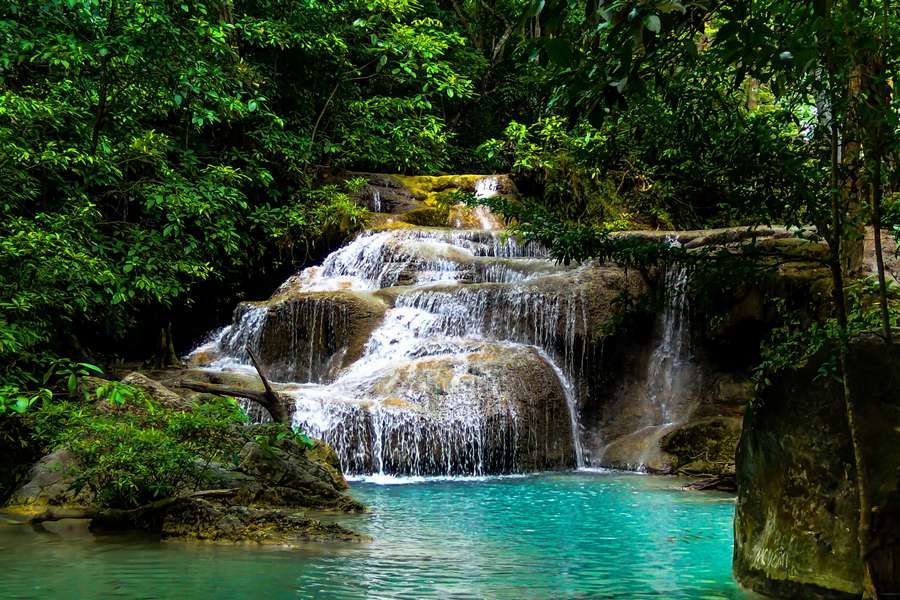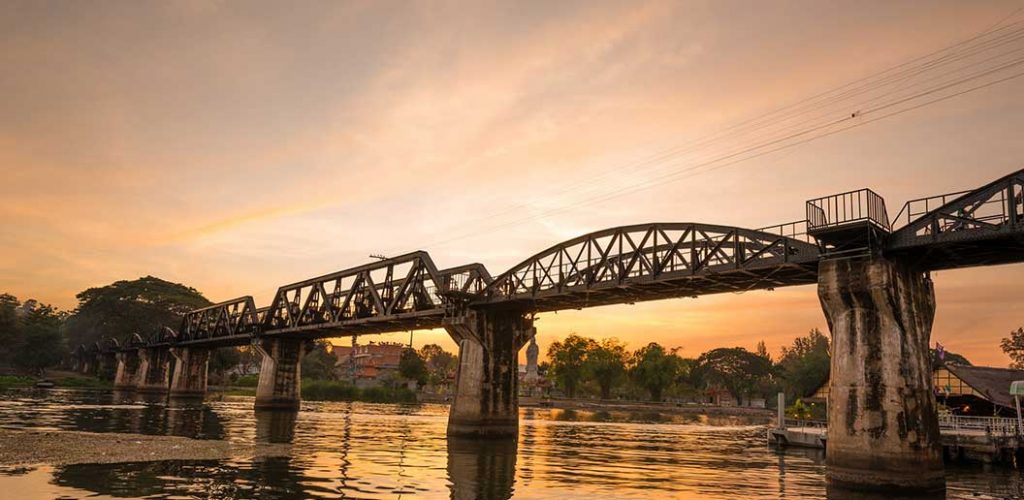Paris has the Eiffel Tower, London its Clock Tower, New York the Empire State Building, Sydney an Opera House, Seattle has the Space Needle and in Kanchanaburi it’s a bridge.
 In 1942 during World War II, Kanchanaburi was under Japanese control. It was here that they forced Asian labourers along with Allied POWs to build the infamous Burma Railway. It was nicknamed the Death Railway because almost half of the prisoners working on the project died from disease, maltreatment, or accidents.
In 1942 during World War II, Kanchanaburi was under Japanese control. It was here that they forced Asian labourers along with Allied POWs to build the infamous Burma Railway. It was nicknamed the Death Railway because almost half of the prisoners working on the project died from disease, maltreatment, or accidents.
While working on the railway in Kanchanaburi the workers were forced to build a bridge, a bridge that became world famous due to the 1957 Hollywood movie classic The Bridge on the River Kwai.
 The Hellfire Pass Memorial documents the history of how the Japanese army forced Allied prisoners to build a railway through Burma and western Thailand. The museum is situated at the site where prisoners labored night and day, often with torches that resembled the fires of Hell. The city is also home to the Kanchanaburi War Cemetery.
The Hellfire Pass Memorial documents the history of how the Japanese army forced Allied prisoners to build a railway through Burma and western Thailand. The museum is situated at the site where prisoners labored night and day, often with torches that resembled the fires of Hell. The city is also home to the Kanchanaburi War Cemetery.
But Kanchanaburi, 123 km west of Bangkok, is so much more, especially for nature lovers. Our HOT Magazine research team spent a few enjoyable days in this historic city and here are their sightseeing suggestions in addition to the museum’s and must-see bridge.
Erawan National Park
 Just a short drive from town is the Erawan National Park which was founded in 1975 and is Thailand’s 12th National Park. The park consists of forest and limestone hills with picturesque plains. Deciduous forest covers 81 percent of the park, while the remainder is blanketed in evergreens, making the whole area a real haven for nature lovers. The number one attraction here is the Erawan Waterfall. The waterfall consists of seven levels with a sapphire green pond in each. The waterfall got its name from its top tier which is said to resemble the three-headed elephant of Hindu Mythology, hence the name ‘Erawan’. Wildlife watching possibilities are limited although deeper into the forest some animals and birds can be found.
Just a short drive from town is the Erawan National Park which was founded in 1975 and is Thailand’s 12th National Park. The park consists of forest and limestone hills with picturesque plains. Deciduous forest covers 81 percent of the park, while the remainder is blanketed in evergreens, making the whole area a real haven for nature lovers. The number one attraction here is the Erawan Waterfall. The waterfall consists of seven levels with a sapphire green pond in each. The waterfall got its name from its top tier which is said to resemble the three-headed elephant of Hindu Mythology, hence the name ‘Erawan’. Wildlife watching possibilities are limited although deeper into the forest some animals and birds can be found.
Srinakarin National Park
 Srinakarin National Park is another perfect choice for nature lovers in Kanchanaburi. It is famed primarily for the spectacular Huay Mae Khamin Waterfall, which crashes down towards the Khwae Yai River and is said to be the most stunning waterfall in Thailand. It is further out of town so it’s less populated than the closer Erawan Falls. Adventurous visitors can also visit caves around the park. History lovers must not miss Tham Sawan and Tham Phra caves where prehistoric paintings rub shoulders with a wondrous Buddha image. Animals like leopards, bats and orioles also patrol the park – so keep your eyes open.
Srinakarin National Park is another perfect choice for nature lovers in Kanchanaburi. It is famed primarily for the spectacular Huay Mae Khamin Waterfall, which crashes down towards the Khwae Yai River and is said to be the most stunning waterfall in Thailand. It is further out of town so it’s less populated than the closer Erawan Falls. Adventurous visitors can also visit caves around the park. History lovers must not miss Tham Sawan and Tham Phra caves where prehistoric paintings rub shoulders with a wondrous Buddha image. Animals like leopards, bats and orioles also patrol the park – so keep your eyes open.
Srinkarin Dam
 Named after Princess Srinagarindra, the Srinakarin Dam is built on the Kwae Yai River in the Srisawat District. The dual-purpose dam is for river regulation and hydroelectric power generation. The lake created by the dam has a breathtaking view with surrounding mountains. It is also an excellent spot of fishing and has become one of the most important attraction sites in Kanchanaburi Province. Initial construction on the dam began in 1974 and it was complete in 1980. The original cost of the dam was estimated to be $45 million but because the dam was constructed on a fault line, the dam’s foundation had to be reinforced which raised the cost to $114 million.
Named after Princess Srinagarindra, the Srinakarin Dam is built on the Kwae Yai River in the Srisawat District. The dual-purpose dam is for river regulation and hydroelectric power generation. The lake created by the dam has a breathtaking view with surrounding mountains. It is also an excellent spot of fishing and has become one of the most important attraction sites in Kanchanaburi Province. Initial construction on the dam began in 1974 and it was complete in 1980. The original cost of the dam was estimated to be $45 million but because the dam was constructed on a fault line, the dam’s foundation had to be reinforced which raised the cost to $114 million.
Muang Singh Historical Park
 The Muang Singh Historical Park protects the remains of two Khmer temples dating to the 13th and 14th centuries. It was declared a historical park in 1987.
The Muang Singh Historical Park protects the remains of two Khmer temples dating to the 13th and 14th centuries. It was declared a historical park in 1987.
The history of the site goes back to the period between 857 and 1157, a period when the Khmer Kingdom was flourishing. Records show that the town was abandoned until the reign of King Rama I. The name Mueang Sing first showed in the chronicles of the reign of King Rama I (1782-1809), when it was a fortified town protecting the town Kanchanaburi.
Surrounded by limestone hills on the bank of the Kwai river, the ancient city is almost square-shaped with moats, ramparts and laterite city walls. The wall is 880 meters long with gates on all four sides. There is an embankment of earth on each of the other inner sides of the wall; the outer sides are enclosed with seven moats and ramparts. These moats and ramparts were probably constructed for the water control system as well as for fortification. During repair, fine art departments had found many significant art pieces that are similar to the ones in Cambodia. These statues are now kept in the Bangkok National Museum. Reproductions of the statues are displayed at the castle.
Kanchanaburi Night Markets
Wherever you go in Thailand you are never far from a night market and Kanchanaburi has two located in the city. The main market is at the train station which has stalls selling just about anything you would want to buy (and plenty of things you won’t). The second and smaller market is at the main bus station. This one is less touristy, and the prices are slightly less, if you are staying in the area and will be cooking at any point this is a great place to pick up your fresh produce. The food market starts daily at 6:00 PM and you will find various local Thai specialties and home-made Thai sweets. The choice is huge and often unexpectedly delicious.
While the offerings at most souvenir stalls and open-air markets do not often stray beyond typical tourist knick-knacks, Kanchanaburi can be an exciting place to shop for quality gemstones. Here is the centre of Thailand’s gemstone mining industry, and Bo Ploi, a district within Kanchanaburi province, is one of the world’s largest production centres for blue sapphires. You will find these brilliant sapphires along with other precious and semi-precious stones at nearly every souvenir stall at various tourist attractions. But if quality is your biggest concern, then head over to Bo Ploi.
 The eastern approach to the Bridge over the River Kwai is one other area worth checking out. These stalls feature a diverse collection of crafts and home décor items, including bamboo crafts, readymade wear, Thai musical instruments, ceramics, lacquerware, bronzeware, paper parasols, silk and gemstones.
The eastern approach to the Bridge over the River Kwai is one other area worth checking out. These stalls feature a diverse collection of crafts and home décor items, including bamboo crafts, readymade wear, Thai musical instruments, ceramics, lacquerware, bronzeware, paper parasols, silk and gemstones.
Just like there is much more to Paris than the Eiffel Tower, there is so much more to see and do in Kanchanaburi than visiting the bridge and war museums. But like the Eiffel Tower, those are two things you don’t want to miss while you are here.


